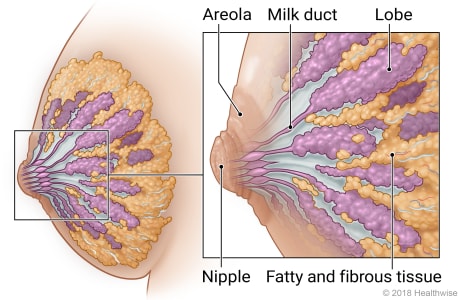Our Health Library information does not replace the advice of a doctor. Please be advised that this information is made available to assist our patients to learn more about their health. Our providers may not see and/or treat all topics found herein.
Anatomy of the female breast

The lobes, milk ducts, areola, nipple, and fatty and fibrous tissue are the main parts of the female breast.
Fat and fibrous tissue make up most of the breast. The lobes and ducts are spread throughout this tissue. Some women have "dense" breasts. This means there is more fibrous tissue than fat.
At childbirth, the lobes produce milk. The milk flows through the milk ducts to the nipple. Around the nipple is the areola. It contains tiny glands that lubricate the nipple during breast feeding. The areola also contains smooth muscles that cause the nipple to push out. This makes it easier for a baby to latch on during breastfeeding.
Current as of: May 5, 2025
Author: Ignite Healthwise, LLC Staff
Clinical Review Board
All Ignite Healthwise, LLC education is reviewed by a team that includes physicians, nurses, advanced practitioners, registered dieticians, and other healthcare professionals.
This information does not replace the advice of a doctor. Ignite Healthwise, LLC disclaims any warranty or liability for your use of this information. Your use of this information means that you agree to the Terms of Use and Privacy Policy. Learn how we develop our content.
To learn more about Ignite Healthwise, LLC, visit webmdignite.com.
© 2024-2025 Ignite Healthwise, LLC.


